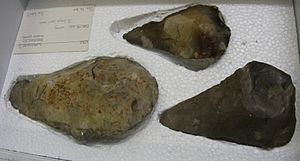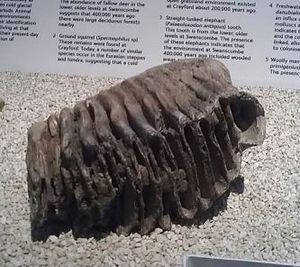Swanscombe Heritage Park facts for kids
Swanscombe Heritage Park, also known as the Swanscombe Skull Site, is a very special place in north-west Kent, England. It covers about 3.9 hectares (that's about 9.6 acres, or roughly the size of 7 football fields!). This park is famous because it's where some incredibly old human bones and tools from the Stone Age were found.
This area used to be a gravel quarry called Barnfield Pit. Even before the famous skull was found, people knew this place was important. Many ancient stone tools, especially hand axes, were discovered here. These tools were made by early humans during the Paleolithic (pronounced Pay-lee-oh-LITH-ik) period, which is also known as the Old Stone Age. Some of these tools are an amazing 400,000 years old!
Contents
The Swanscombe Skull Discovery
The most exciting discovery at Swanscombe happened in 1935 and 1936. Workers at Barnfield Pit found two pieces of a fossilized skull. At first, they thought these bones belonged to a man, so they called the find "Swanscombe Man." But later, scientists realized the skull fragments actually belonged to a young woman!
These skull pieces are incredibly old, dating back about 400,000 years. Scientists believe they belonged to an early Neanderthal (pronounced Nee-AN-der-tahl), a type of ancient human. This makes the Swanscombe skull one of the oldest human fossils ever found in Britain!
What We Learned from the Skull
The skull fragments were found almost eight meters (about 26 feet) deep in the ground, buried in gravel. This tells us a lot about how old they are and the ancient environment. Later digs between 1968 and 1972 found even more animal bones and flint tools. These discoveries helped scientists understand that the bones were found near what used to be an ancient shoreline.
Ancient Tools and Animals
Besides the skull, many other fascinating things have been found at Swanscombe. These include lots of stone tools, like the hand axes mentioned earlier, which show how early humans lived and hunted. Scientists also found bones from ancient animals, like the huge mammoth. These animal remains help paint a picture of what the world was like 400,000 years ago, including the types of animals that lived alongside early humans.
Where to See the Finds
Most of the ancient bones found at Swanscombe, including the famous skull fragments, are now kept at the Natural History Museum in London. The stone tools and other artifacts are displayed at the British Museum. These museums help protect these important discoveries and allow people to learn about our ancient past.
Swanscombe Heritage Park is a truly special place that helps us understand the very first humans who lived in Britain and how they survived hundreds of thousands of years ago.



